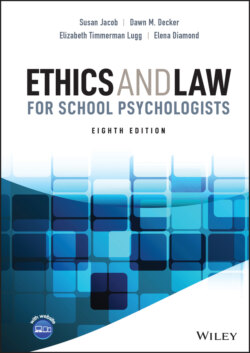Читать книгу Ethics and Law for School Psychologists - Susan Jacob - Страница 90
CASE LAW
ОглавлениеA third source of law is case law. Case law, or common law, is law that emerges from court decisions (Russo, 2018). The common law system can be traced back to medieval England. At that time, it was widely accepted that there were “laws of nature” to guide solutions to problems if those laws could be discovered. Legal scholars studied past court decisions for the purpose of discovering those “natural laws.” The rules and principles that judges customarily followed in making decisions were identified and, at times, articulated in case decisions, and judges tended to base new decisions on those earlier legal precedents. Common law is thus discovered law rather than enacted law (Russo, 2018, p. 1). Many aspects of public school law today are based on common law rather than enacted law, as Russo pointed out. For example, the courts generally have upheld a teacher’s right to use corporal punishment to discipline students where no state laws or school board policies prohibit its use. Acceptance of the use of corporal punishment in the schools by courts has a long history in case law (see Chapter 9).
In the United States, the federal court system has three tiers or layers; most state court systems also have three tiers or layers. As H. R. Turnbull and Turnbull (2000, p. 6) observed, “Why a case may be tried in one court, appealed or reviewed by another, and finally disposed of by yet another is a matter of great complexity.” A brief discussion of the state and federal court systems follows.
State court systems vary in organization and complexity. Cases filed in the lowest court may be appealed to an intermediate-level court, if a state has one. Decisions then may be appealed to the supreme court of the state, the “court of last resort” (Russo, 2018). The U.S. Supreme Court may review cases from a state court if a question of federal law is involved. Within the federal system, at the lowest level are the trial courts, called district courts. Nearly 100 federal district courts exist. At the intermediate level are 11 numbered federal circuits or geographical areas and the District of Columbia. Each court at this level is called a circuit court of appeals. These courts hear appeals from the district courts. They decide issues of law, not fact. The highest court in the federal system is the U.S. Supreme Court. A person who loses a case in a federal court of appeals or the highest state court may submit a written petition requesting the Supreme Court to review the case. The Supreme Court agrees to review a case by granting a writ of certiorari (an order calling up a case from a lower court for review). However, the Supreme Court selects only those cases it considers most important to review, and consequently, only a small percentage of the requests for review are granted.
The federal court system decides both civil and criminal cases. Criminal cases involve crimes prosecuted by the government, not private citizens (e.g., murder, theft, and assault). Civil cases are lawsuits brought by private parties. Federal courts rule only on cases that involve federal constitutional or statutory law or cases that involve parties from two different states. The U.S. Supreme Court has the final authority in interpreting the U.S. Constitution and federal statutes. State courts also decide both civil and criminal cases. State courts rule on cases involving state and statutory law, but also may rule on cases involving the federal Constitution and statutory laws.
The role of the courts is to resolve disputes involving citizens, organizations, and the government. Courts also decide the guilt or innocence of those accused of crimes. In education, most disputes are decided in civil court. Courts decide conflicts by applying law to a given set of facts and interpreting the meaning of the law in that context. It is the function of courts to say what the Constitution or statute means in a given case, set forth the findings of fact that the interpretation is based on, and enter an order commanding the parties in the case to take certain action (or, if the case is on appeal, the judge may enter an order for another court to take action). If there is no codified law (no constitutional or statutory provision) found controlling in a case, the court is likely to rely on common law (legal precedents) in rendering a decision (Hubsch, 1989; H. R. Turnbull & Turnbull, 2000). In reading about court rulings, remember that decisions of the U.S. Supreme Court are binding throughout the country. The decisions of the lower federal courts are binding only within their jurisdictions, and the decisions of state courts are binding only within the state (Russo, 2018).
